Future Swedish 3D City Models—Specifications, Test Data, and Evaluation
Abstract
1. Introduction
2. Review of the Literature
2.1. Applications of 3D City Models
2.2. Standardisation of 3D City Models
2.2.1. CityGML/CityJSON
2.2.2. Extending CityGML
2.2.3. Swedish National Specifications for Geodata
2.3. Measuring Guidelines
3. Motivation and Specifications of 3CIM
3.1. Motivation to Develop the 3CIM Specifications
3.2. Methodology for Designing the 3CIM Specifications
3.2.1. CIM Design Decisions
3.2.2. Usage of CityGML 2.0
3.2.3. Linkages to Operational Systems and External Data Sets/Registers
3.2.4. Connection to the National Specifications of Geodata
3.2.5. Only Physical Objects Are Included in 3CIM
3.2.6. No Versioning in This Version of 3CIM
3.2.7. Language and Attribute Value Lists
3.2.8. Land-Cover Data
3.2.9. Elevation Data
3.3. Overview of the 3CIM Specifications
3.3.1. Core Module
3.3.2. Building Theme
3.3.3. Transportation Theme
3.3.4. Vegetation Theme
4. Creation of 3CIM Test Data
4.1. Study Areas in the Three Cities
4.2. Creation of 3CIM Ver. 0.2 Data in Malmö
4.2.1. Building Theme
4.2.2. Window Data
4.2.3. Transportation Theme
4.2.4. Vegetation Theme
5. Evaluation of the 3CIM Specifications and the Test Data
5.1. Storage of the 3CIM Data
5.2. Visualisation
5.2.1. Visualisation in Unreal Engine
5.2.2. Visualisation in Digital Twin City Viewer
5.3. Noise Simulations
5.4. Daylight Simulations
5.5. Flood Simulations
6. Discussion
6.1. The 3CIM Specifications
6.2. International Standards
6.3. Creating 3CIM Test Data
6.4. Evaluation of the Applications
6.4.1. Storage of the 3CIM Data
6.4.2. Visualisation
6.4.3. Simulations
6.5. Data Quality Issues
6.6. Linking 3CIM to External Data—Using Linked Data
7. Concluding Remarks
Author Contributions
Funding
Data Availability Statement
Acknowledgments
Conflicts of Interest
References
- Stoter, J.; van Den Brink, L.; Beetz, J.; Ledoux, H.; Reuvers, M.; Janssen, P.; Penninga, F.; Vosselman, G.; Oude Elberink, S. Three-dimensional modeling with national coverage: Case of The Netherlands. Geo-Spat. Inf. Sci. 2013, 16, 267–276. [Google Scholar] [CrossRef]
- Gruber, U.; Riecken, J.; Seifert, M. Germany on the Way to 3D-Cadastre. In Proceedings of the FIG Congress, Kuala Lumpur, Malaysia, 16–21 June 2014. [Google Scholar]
- Van den Brink, L.; Stoter, J.; Zlatanova, S. Establishing a national standard for 3D topographic data compliant to CityGML. Int. J. Geogr. 2013, 27, 92–113. [Google Scholar] [CrossRef]
- Eriksson, H.; Johansson, T.; Olsson, P.-O.; Andersson, M.; Engvall, J.; Hast, I.; Harrie, L. Requirements, Development, and Evaluation of A National Building Standard—A Swedish Case Study. ISPRS Int. J. Geo-Inf. 2020, 9, 78. [Google Scholar] [CrossRef]
- Stoter, J.E.; Ledoux, H.; Penninga, F.; van den Brink, L.; Reuvers, M.; Vermeij, M.; Wiersma, M.G. Towards a generic 3D standardisation approach for the Netherlands supporting different applications and encodings. In The International Archives of the Photogrammetry, Remote Sensing and Spatial Information Sciences, Proceedings of 14th 3D GeoInfo Conference, Singapore, 24–27 September 2019; Copernicus GmbH: Göttingen, Germany, 2019; Volume XLII-4/W15, pp. 89–96. [Google Scholar]
- Ates Aydar, S.; Yomralıoglu, T.; Demir Ozbek, E. Modeling Turkey National 2D Geo-Data Model as a CityGML Application Domain Extension in UML. Int. J. Environ. Geoinform. 2016, 3, 1–10. [Google Scholar] [CrossRef]
- Liamis, T.; Mimis, A. Establishing Semantic 3D City Models by GRextADE: The Case of the Greece. J. Geovis. Spat. Anal. 2022, 6, 15. [Google Scholar] [CrossRef]
- Jeansson, E. Virtual Gothenburg–A Digital Twin of the City. 2019. Available online: https://geospatialworldforum.org/speaker/presentions2019/Virtual-Gothenburg-A-digital-twin-of-the-city-Eric_Jeansson.pdf (accessed on 7 December 2022).
- Helsinki. The Kalasatama Digital Twins Project, the Final Report of the KIRA-Digi Pilot Project. 2019. Available online: https://www.hel.fi/static/liitteet-2019/Kaupunginkanslia/Helsinki3D_Kalasatama_Digital_Twins.pdf (accessed on 6 June 2022).
- Ruohomäki, T.; Airaksinen, E.; Huuska, P.; Kesäniemi, O.; Martikka, M.; Suomisto, J. Smart city platform enabling digital twin. In Proceedings of the 2018 International Conference on Intelligent Systems (IS), Funchal, Portugal, 25–27 September 2018; pp. 155–161. [Google Scholar] [CrossRef]
- Singapore. Virtual Singapore. Government of Singapore. 2021. Available online: https://www.nrf.gov.sg/programmes/virtual-singapore (accessed on 6 June 2022).
- Schrotter, G.; Hürzeler, C. The digital twin of the City of Zurich for urban planning. PFG–Journal of Photogrammetry. Remote Sens. Geoinf. Sci. 2020, 88, 99–112. [Google Scholar] [CrossRef]
- Kumar, K.; Ledoux, H.; Commandeur, T.J.F.; Stoter, J.E. Modelling urban noise in CityGML ADE: Case of the Netherlands. In ISPRS Annals of the Photogrammetry, Remote Sensing and Spatial Information Sciences, Proceedings of ISPRS 12th Geoinfo Conference, Melbourne, Australia, 26–27 October 2017; Copernicus GmbH: Göttingen, Germany, 2017; Volume IV-4/W5, pp. 73–81. [Google Scholar]
- Wate, P.; Coors, V. 3D data models for urban energy simulation. Energy Procedia 2015, 78, 3372–3377. [Google Scholar] [CrossRef]
- Ang, Y.Q.; Berzolla, Z.; Reinhart, C. From concept to application: A review of use cases in urban building energy modeling. Appl. Energy 2020, 279, 115738. [Google Scholar] [CrossRef]
- Kanters, J.; Gentile, N.; Bernardo, R. Planning for solar access in Sweden: Routines, metrics, and tools. Urban Plan. Transp. Res. 2021, 9, 348–368. [Google Scholar] [CrossRef]
- Reiter, S. Assessing wind comfort in urban planning. Environ. Plan. B 2010, 37, 857–873. [Google Scholar] [CrossRef]
- Charlton, J.; Giddings, B.; Thompson, E.M.; Peverett, I. Understanding the interoperability of virtual city models in assessing the performance of city centre squares. Environ. Plan. A 2015, 47, 1298–1312. [Google Scholar] [CrossRef]
- Harrie, L.; Kanters, J.; Mattisson, K.; Nezval, P.; Olsson, P.-O.; Pantazatou, K.; Kong, G.; Fan, H. 3D City models for supporting simulations in city densifications. Int. Arch. Photogramm. Remote Sens. Spat. Inf. Sci. 2021, XLVI-4/W4-2021, 73–77. [Google Scholar] [CrossRef]
- Noardo, F.; Arroyo Ohori, K.; Biljecki, F.; Ellul, C.; Harrie, L.; Krijnen, T.; Eriksson, H.; van Liempt, J.; Pla, M.; Ruiz, A.; et al. Reference study of CityGML software support: The GeoBIM benchmark 2019—Part II. Trans. GIS 2021, 25, 842–868. [Google Scholar] [CrossRef]
- Van Berlo, L.; Dijkmans, T.; Stoter, J. Experiment for integrating Dutch 3D spatial planning and BIM for checking building permits. In ISPRS Annals of the Photogrammetry, Remote Sensing and Spatial Information Sciences, Proceedings of ISPR 8th 3DGeoInfo Conference & WG II/2 Workshop, Istanbul, Turkey, 27–29 November 2013; Copernicus GmbH: Göttingen, Germany, 2013; Volume II-2/W1, pp. 279–284. [Google Scholar]
- Olsson, P.; Axelsson, J.; Hooper, M.; Harrie, L. Automation of building permission by integration of BIM and geospatial data. ISPRS Int. J. Geo-Inf. 2018, 7, 307. [Google Scholar] [CrossRef]
- Noardo, F.; Ellul, C.; Harrie, L.; Oveland, I.; Shariat, M.; Stoter, J.; Arroyo Ohori, K. Opportunities and Challenges for GeoBIM in Europe: Developing a building permits use-case to raise awareness and examine technical interoperability challenges. J. Spat. Sci. 2019, 65, 209–233. [Google Scholar] [CrossRef]
- Sun, J.; Mi, S.; Olsson, P.-O.; Paulsson, J.; Harrie, L. Utilizing BIM and GIS for Representation and Visualization of 3D Cadastre. ISPRS Int. J. Geo-Inf. 2019, 8, 503–527. [Google Scholar] [CrossRef]
- Kalogianni, E.; van Oosterom, P.; Dimopoulou, E.; Lemmen, C. 3D Land Administration: A Review and a Future Vision in the Context of the Spatial Development Lifecycle. ISPRS Int. J. Geo-Inf. 2020, 9, 107. [Google Scholar] [CrossRef]
- Liu, X.; Wang, X.Y.; Wright, G.; Cheng, J.C.P.; Li, X.; Liu, R. A State-of-the-Art Review on the Integration of Building Information Modeling (BIM) and Geographic Information System (GIS). ISPRS Int. J. Geo-Inf. 2017, 6, 52. [Google Scholar] [CrossRef]
- Stouffs, R.; Tauscher, H.; Biljecki, F. Achieving Complete and Near-Lossless Conversion from IFC to CityGML. ISPRS Int. J. Geo-Inf. 2018, 7, 355. [Google Scholar] [CrossRef]
- Chaturvedi, K.; Kolbe, T.H. Towards Establishing Cross-Platform Interoperability for Sensors in Smart Cities. Sensors 2019, 19, 562. [Google Scholar] [CrossRef]
- Ketzler, B.; Naserentin, V.; Latino, F.; Zangelidis, C.; Thuvander, L.; Logg, A. Digital Twins for Cities: A State of the Art Review. Built Environ. 2020, 46, 547–573. [Google Scholar] [CrossRef]
- Mohammadi, N.; Taylor, J. Knowledge discovery in smart city digital twins. In Proceedings of the 53th Hawaii International Conference on System Sciences, Maui, HI, USA, 7–10 January 2020. [Google Scholar]
- Nam, T.; Pardo, T.A. Conceptualizing Smart City with Dimensions of Technology, People, and Institutions. In Proceedings of the 12th Annual International Digital Government Research Conference: Digital Government Innovation in Challenging Times, College Park, MD, USA, 12–15 June 2011; pp. 282–291. [Google Scholar] [CrossRef]
- Lim, C.; Kim, K.-J.; Maglio, P.P. Smart cities with big data: Reference models, challenges, and considerations. Cities. 2018, 82, 86–99. [Google Scholar] [CrossRef]
- Sarker, I.H. Smart City Data Science: Towards data-driven smart cities with open research issues. Internet Things 2022, 19, 100528. [Google Scholar] [CrossRef]
- Ruggedised. Project Webpage. 2019. Available online: https://ruggedised.eu/home/ (accessed on 25 May 2022).
- Colding, J.; Colding, M.; Barthel, S. The smart city model: A new panacea for urban sustainability or unmanageable complexity? Environ. Plan. B 2020, 47, 179–187. [Google Scholar] [CrossRef]
- Gröger, G.; Kolbe, T.H.; Nagel, C.; Häfele, K.H. (Eds.) OGC City Geography Markup Language (CityGML) Encoding Standard, Ver 2.0. 2012. Available online: http://www.opengeospatial.org/standards/citygml (accessed on 25 May 2022).
- Gröger, G.; Plümer, L. CityGML–Interoperable semantic 3D city models. ISPRS J. Photogramm. Remote Sens. 2012, 71, 12–33. [Google Scholar]
- Kolbe, T.H.; Kutzner, T.; Smyth, C.S.; Nagel, C.; Roensdorf, C.; Heazel, C. (Eds.) OGC City Geography Markup Language (CityGML) Part 1: Conceptual Model Standard, Ver 3.0.0. 2021. Available online: http://www.opengeospatial.org/standards/citygml (accessed on 25 May 2022).
- Kutzner, T.; Chaturvedi, K.; Kolbe, T.H. CityGML 3.0: New Functions Open Up New Applications. PFG. PFG 2020. [Google Scholar] [CrossRef]
- Yao, Z.; Nagel, C.; Kunde, F.; Hudra, G.; Willkomm, P.; Donaubauer, A.; Adolphi, T.; Kolbe, T.H. 3DCityDB-a 3D geodatabase solution for the management, analysis, and visualization of semantic 3D city models based on CityGML. Open Geospat. Data Softw. Stand. 2018, 3, 5. [Google Scholar] [CrossRef]
- Ledoux, H.; Arroyo Ohori, K.; Kumar, K.; Dukai, B.; Labetski, A.; Vitalis, S. CityJSON: A compact and easy-to-use encoding of the CityGML data model. Open Geospat. Data Softw. Stand. 2019, 4, 4. [Google Scholar] [CrossRef]
- Nouvel, R.; Bahu, J.M.; Kaden, R.; Kaempf, J.; Cipriano, P.; Lauster, M.; Haefele, K.H.; Munoz, E.; Tournaire, O.; Casper, E. Development of the CityGML Application Domain Extension Energy for Urban Energy Simulation. In Proceedings of the 14th Conference of International Building Performance Simulation Association, Hyderabad, India, 7–9 December 2015; pp. 559–564. [Google Scholar]
- Agugiaro, G.; Benner, J.; Cipriano, P.; Nouvel, R. The Energy Application Domain Extension for CityGML: Enhancing interoperability for urban energy simulations. Open Geospat. Data Softw. Stand. 2018, 3, 13. [Google Scholar] [CrossRef]
- Czerwinski, A.; Sandmann, S.; Elke, S.-M.; Plümer, L. Sustainable SDI for EU noise mapping in NRW–best practice for INSPIRE. Int. J. Spat. Data Infrastruct. Res. 2007, 2, 90–111. [Google Scholar]
- Gózdz, K.; Pachelski, W.; van Oosterom, P.J.M.; Coors, V. The possibilities of using CityGML for 3D representation of buildings in the cadastre. In Proceedings of the 4th International Workshop on 3D Cadastres. Dubai: International Federation of Surveyors (FIG), Dubai, United Arab Emirates, 9–11 November 2014; pp. 339–362. [Google Scholar]
- Li, L.; Wu, J.; Zhu, H.; Duan, X.; Luo, F. 3D modeling of the ownership structure of condominium units. Comput. Environ. Urban Syst. 2016, 59, 50–63. [Google Scholar] [CrossRef]
- Biljecki, F.; Kumar, K.; Nagel, C. CityGML Application Domain Extension (ADE): Overview of developments. Open Geospat. Data Softw. Stand. 2018, 3, 13. [Google Scholar] [CrossRef]
- Billen, R.; Cutting-Decelle, A.-F.; Marina, O.; Almeida, J.-P.d.M.C.; Falquet, G.; Leduc, T.; Métral, C.; Moreau, G.; Perret, J.; Rabin, G.; et al. 3D City Models and Urban Information: Current Issues and Perspectives. In European COST Action TU080; EDP Sciences: Les Ulis, France, 2014. [Google Scholar]
- El-Mekawy, M.; Östman, A.; Hijazi, I. A Unified Building Model for 3D Urban GIS. ISPRS Int. J. Geo-Inf. 2012, 1, 120–145. [Google Scholar] [CrossRef]
- Eriksson, H.; Harrie, L. Versioning of 3D City Models for Municipality Applications: Needs, Obstacles and Recommendations. ISPRS Int. J. Geo-Inf. 2021, 10, 55. [Google Scholar] [CrossRef]
- Lantmäteriet. National Specifications. 2022. Available online: https://www.lantmateriet.se/en/national-geodata-platform/data-sets-in-the-platform/specifications-and-instructions/ (accessed on 6 October 2022).
- SIG3D Quality Working Group. Modeling Guide for 3D Objects Part2: Modeling of Buildings (LoD1, LoD2 and LoD3), Version 2.0.1 EN. 2017. Available online: https://files.sig3d.org/file/ag-qualitaet/201711_SIG3D_Modeling_Guide_for_3D_Objects_Part_2.pdf (accessed on 7 June 2022).
- Blaauboer, J.; Goos, J.; Ledoux, H.; Penninga, F.; Reuvers, M.; Stoter, J.; Vosselman, G.; Commandeur, T. Technical Specifications for the Construction of 3D IMGeo-CityGML, Version 2.1. Available online: https://www.geonovum.nl/uploads/documents/20170102Guidetotender3DCityGMLIMGeo_v2.1_0.pdf (accessed on 7 June 2022).
- Lei, B.; Janssen, P.; Stoter, J.; Biljecki, F. Challenges of urban digital twins: A systematic review and a Delphi expert survey. Autom. Constr. 2023, 147, 104716. [Google Scholar] [CrossRef]
- 3CIM. The 3CIM Project. 2022. Available online: https://www.smartbuilt.se/projekt/informationsinfrastruktur/3cim/ (accessed on 6 October 2022).
- Bendiksen, T. Creating a Workflow of 3D Building Data in a Municipality Context. Master’s Thesis, Dept of Physical Geography and Ecosystem Science, Lund University, Lund, Sweden, 2021. [Google Scholar]
- Eriksson, H.; Sun, J.; Tarandi, V.; Harrie, L. A comparison of versioning methods to improve the flow of building information in the planning and building processes. Trans. GIS 2021, 25, 134–163. [Google Scholar] [CrossRef]
- Chaturvedi, K.; Smyth, C.S.; Gesquière, G.; Kutzner, T.; Kolbe, T.H. Managing versions and history within semantic 3D city models for the next generation of CityGML. In Advances in 3D Geoinformation, Lecture Notes in Cartography and Geoinformation; Abdul-Rahman, A., Ed.; Springer: Berlin/Heidelberg, Germany, 2016. [Google Scholar]
- CoClass. Swedish Digital Construction Classification System for Built Environment. 2022. Available online: https://byggtjanst.se/tjanster/coclass/ (accessed on 18 October 2019).
- Kumar, K.; Ledoux, H.; Stoter, J. A CityGML Extension for Handling Very Large Tins. ISPRS Ann. Photogramm. Remote Sens. Spat. Inf. Sci. 2016, IV-2/W1, 137–143. [Google Scholar] [CrossRef]
- Biljecki, F.; Ledoux, H.; Stoter, J. An improved LOD specification for 3D building models. Comput. Environ. Urban Syst. 2016, 59, 25–37. [Google Scholar] [CrossRef]
- Beil, C.; Kolbe, T.H. Citygml and the Streets of New York-a Proposal for Detailed Street Space Modelling. ISPRS Ann. Photogramm. Remote Sens. Spat. Inf. Sci. 2017, 44W5, 9. [Google Scholar] [CrossRef]
- Beil, C.; Ruhdorfer, R.; Coduro, T.; Kolbe, T.H. Detailed Streetspace Modelling for Multiple Applications: Discussions on the Proposed CityGML 3.0 Transportation Model. ISPRS Int. J. Geo-Inf. 2020, 9, 603. [Google Scholar] [CrossRef]
- Lantmäteriet. 2022. Available online: https://www.lantmateriet.se/sv/geodata/gps-geodesi-och-swepos/Transformationer/gtrans/ (accessed on 13 August 2022).
- Huang, W.; Olsson, P.O.; Kanters, J.; Harrie, L. Reconsiling city models with BIM in knowledge graphs: A feasibility study of data integration for solar energy simulation. ISPRS Ann. Photogramm. Remote Sens. Spat. Inf. Sci. 2021, VI-4/W1-2020, 93–99. [Google Scholar] [CrossRef]
- Dogan, T.; Knutins, M. CitySeek: Towards Urban Daylight Models Based on GIS Data and SemiAutomated Image Processing. In Proceedings of the Symposium on Simulation for Architecture and Urban Design, Delft, The Netherlands, 5–7 June 2018; SIMAUD ‘18. [Google Scholar]
- Kong, G.; Fan, H. Enhanced Facade Parsing for Street-Level Images Using Convolutional Neural Networks. IEEE Trans. Geosci. Remote Sens. 2021, 59, 10519–10531. [Google Scholar] [CrossRef]
- Trafikverket. Introduktion Till NVDBs Vägnät Och Företeelser, Dokumentdatum: 2021-02-12 Version: 1.0. 2022. Available online: https://bransch.trafikverket.se/dataproduktspecifikationer-vag/ (accessed on 15 November 2022).
- Lei, B.; Stouffs, R.; Biljecki, F. Assessing and benchmarking 3D city models. Int. J. Geogr. Inf. Sci. 2022. [Google Scholar] [CrossRef]
- Kephalopoulos, S.; Paviotti, M.; Anfosso-Lédée, F. Common Noise Assessment Methods in Europe (CNOSSOS-EU); Publications Office of the European Union: Brussels, Belgium, 2012. [Google Scholar]
- Kumar, K.; Ledoux, H.; Schmidt, R.; Verheij, T.; Stoter, J. A harmonized data model for noise simulation in the EU. ISPRS Int. J. Geo-Info. 2020, 9, 121. [Google Scholar] [CrossRef]
- Stoter, J.; Peters, R.; Commandeur, T.; Dukai, B.; Kumar, K.; Ledoux, H. Automated reconstruction of 3D input data for noise simulation. Comput. Environ. Urban Syst. 2020, 80, 101424. [Google Scholar] [CrossRef]
- Czachura, A.; Kanters, J.; Gentile, N.; Wall, M. Solar performance metrics in urban planning: A review and taxonomy. Buildings 2022, 12, 393. [Google Scholar] [CrossRef]
- Pantazatou, K.; Kanters, J.; Olsson, P.O.; Harrie, L. Input data requirements for daylight simulations in urban densifications. Under Review. 2022. [Google Scholar]
- Lindberg, F.; Jonsson, P.; Honjo, T.; Wästberg, D. Solar energy on building envelopes–3D modelling in a 2D environment. Sol. Energy 2015, 115, 369–378. [Google Scholar] [CrossRef]
- Lindberg, F.; Wallenburg, N.; Tang, Y.; Grimmond, S.; Sun, T.; Solar Energy-Introduction to SEBE. Solar Energy-Introduction to SEBE-UMEP Tutorial Documentation. 2018. Available online: https://umep-docs.readthedocs.io/projects/tutorial/en/latest/Tutorials/SEBE.html#irradiance-on-building-envelopes (accessed on 7 February 2022).
- Nezval, P. Design, Implementation and Evaluation of a Daylight Estimation Tool Using 3D City Model Data. Master’s Thesis, Lund University, Lund, Sweden, 2021. [Google Scholar]
- Hartman, K. Modelling Solar Access at the Window Level of Buildings–A Case Study for Urban Densification Simulations in Sweden. Master’s Thesis, Lund University, Lund, Sweden, 2022. [Google Scholar]
- Salvadore, E.; Bronders, J.; Batelaan, O. Hydrological Modelling of Urbanized Catchments: A Review and Future Directions. J. Hydrol. 2015, 529, 62–81. [Google Scholar] [CrossRef]
- Nilsson, H.; Pilesjö, P.; Hasan, A.; Persson, A. Dynamic spatio-temporal flow modeling with raster DEMs. Trans. GIS. 2021, 26, 1572–1588. [Google Scholar] [CrossRef]
- Kumar, K.; Labetski, A.; Ledoux, H.; Stoter, J. An improved LOD framework for the terrains in 3D city models. ISPRS Ann. Photogramm. Remote Sens. Spat. Inf. Sci. 2019, IV-4/W8, 75–82. [Google Scholar] [CrossRef]
- Löwner, M.-O.; Gröger, G.; Benner, J.; Biljecki, F.; Nagel, C. Proposal for a new LOD and Multi-Representation Concept for CityGML. In ISPRS Ann. Photogramm. Remote Sens. Spatial Inf. Sci., Proceedings of ISPRS 11th Geoinfo Conference, Athens, Greece, 20–21 October 2016; Copernicus GmbH: Göttingen, Germany, 2016; Volume IV(2/W1), pp. 3–12. [Google Scholar]
- Fan, H.; Kong, G.; Zhang, C. An Interactive platform for low-cost 3D building modeling from VGI data using convolutional neural network. Big Earth Data 2021, 5, 49–65. [Google Scholar] [CrossRef]
- Chadzynski, A.; Krdzavac, N.; Farazi, F.; Lim, M.Q.; Li, S.; Grisiute, A.; Herthogs, P.; von Richthofen, A.; Cairns, S.; Kraft, M. Semantic 3D City Database—An enabler for a dynamic geospatial knowledge graph. Energy AI 2021, 6, 100106. [Google Scholar] [CrossRef]
- Huang, W.; Raza, S.A.; Mirzov, O.; Harrie, L. Assessment and Benchmarking of Spatially-Enabled RDF Stores for the Next Generation of Spatial Data Infrastructure. ISPRS Int. J. Geo-Inf. 2019, 8, 310–329. [Google Scholar] [CrossRef]
- Li, W.; Wanga, S.; Wu, S.; Gu, Z.; Tian, Y. Performance benchmark on semantic web repositories for spatially explicit knowledge graph applications. Comput. Environ. Urban Syst. 2022, 98, 101884. [Google Scholar] [CrossRef]
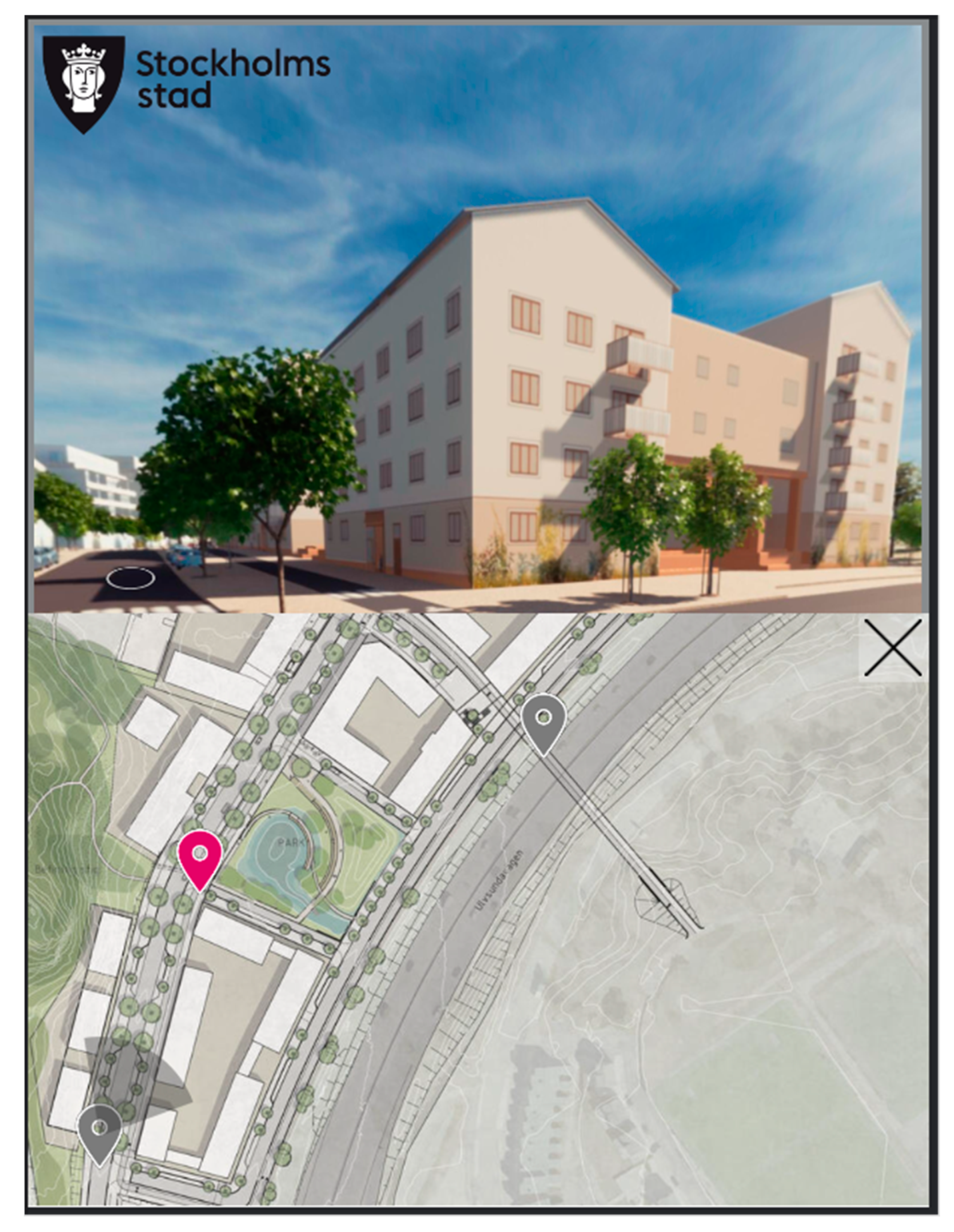

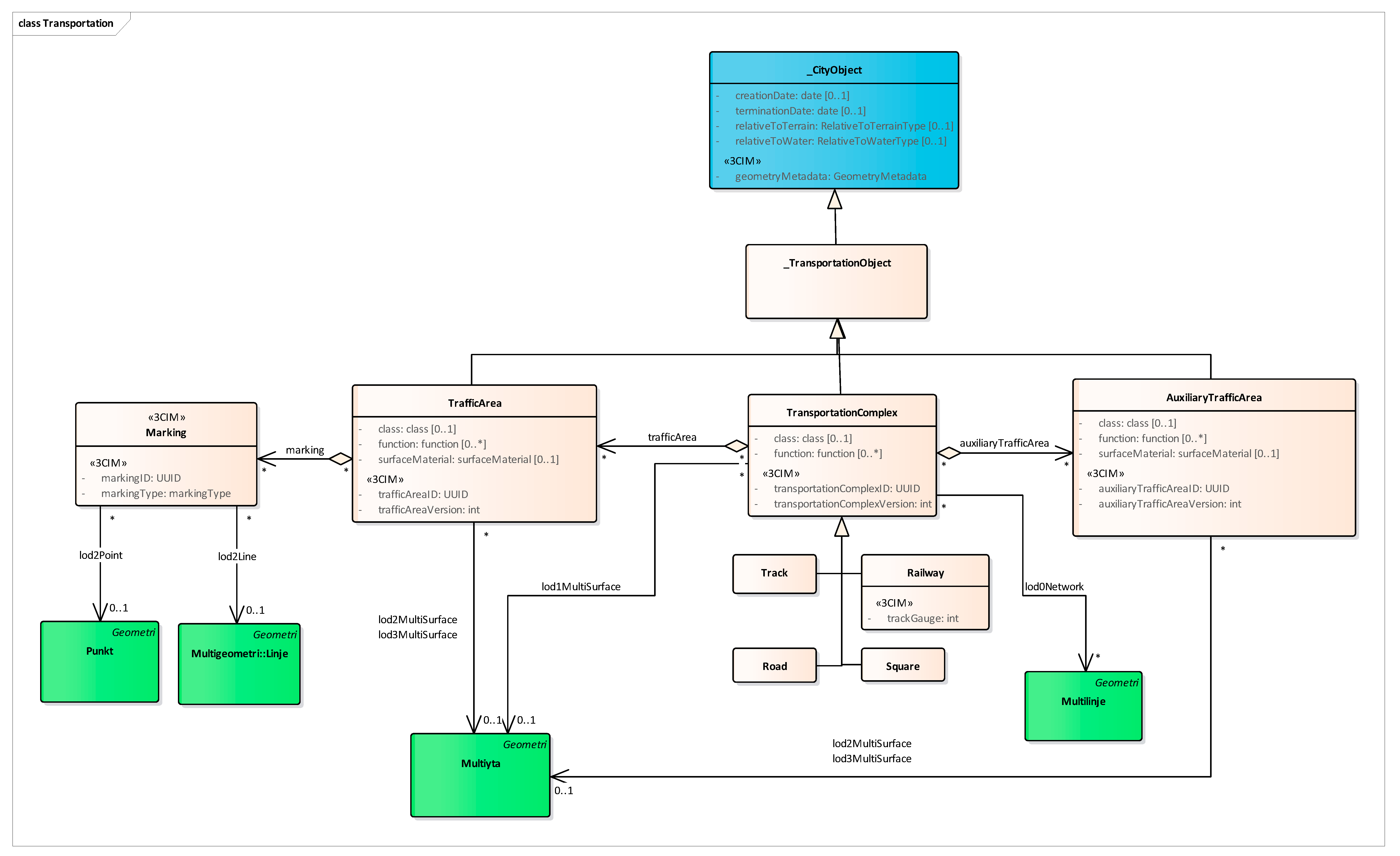

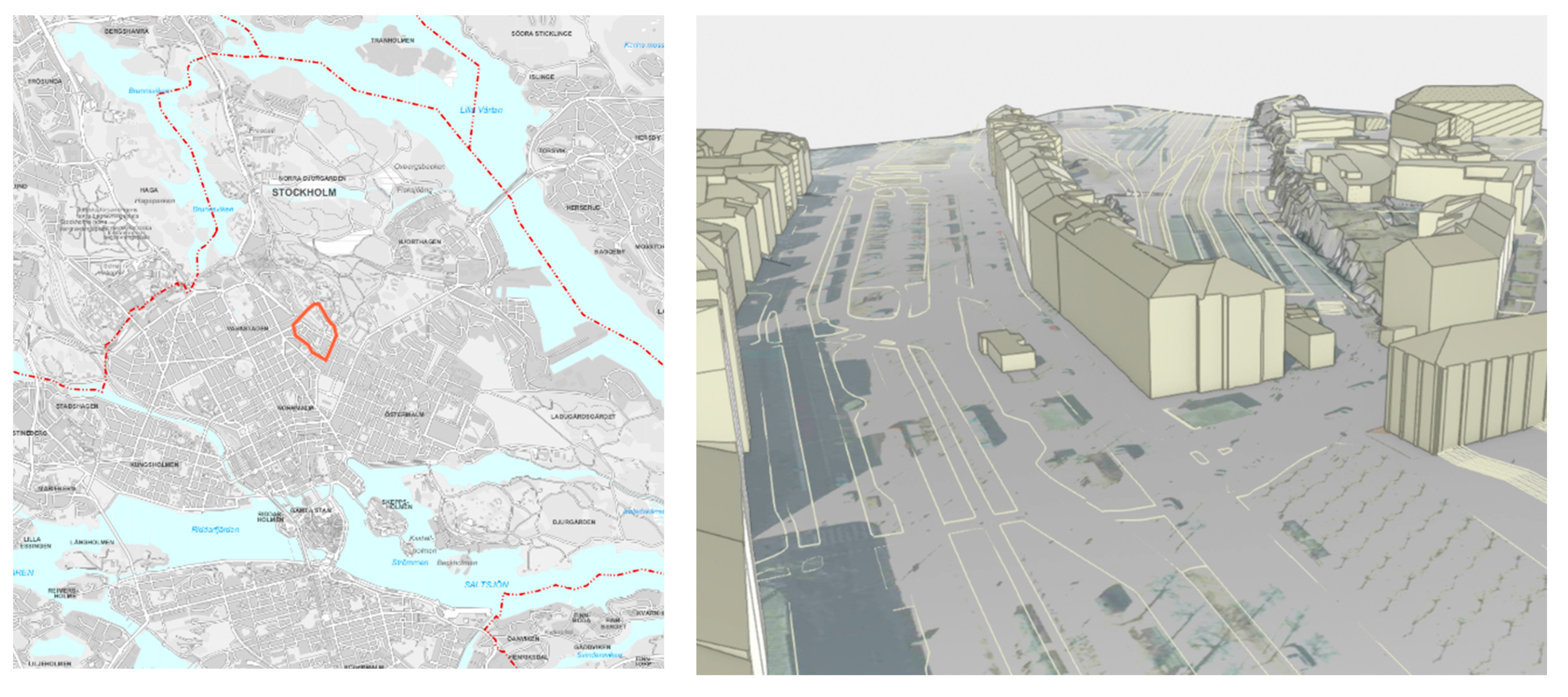


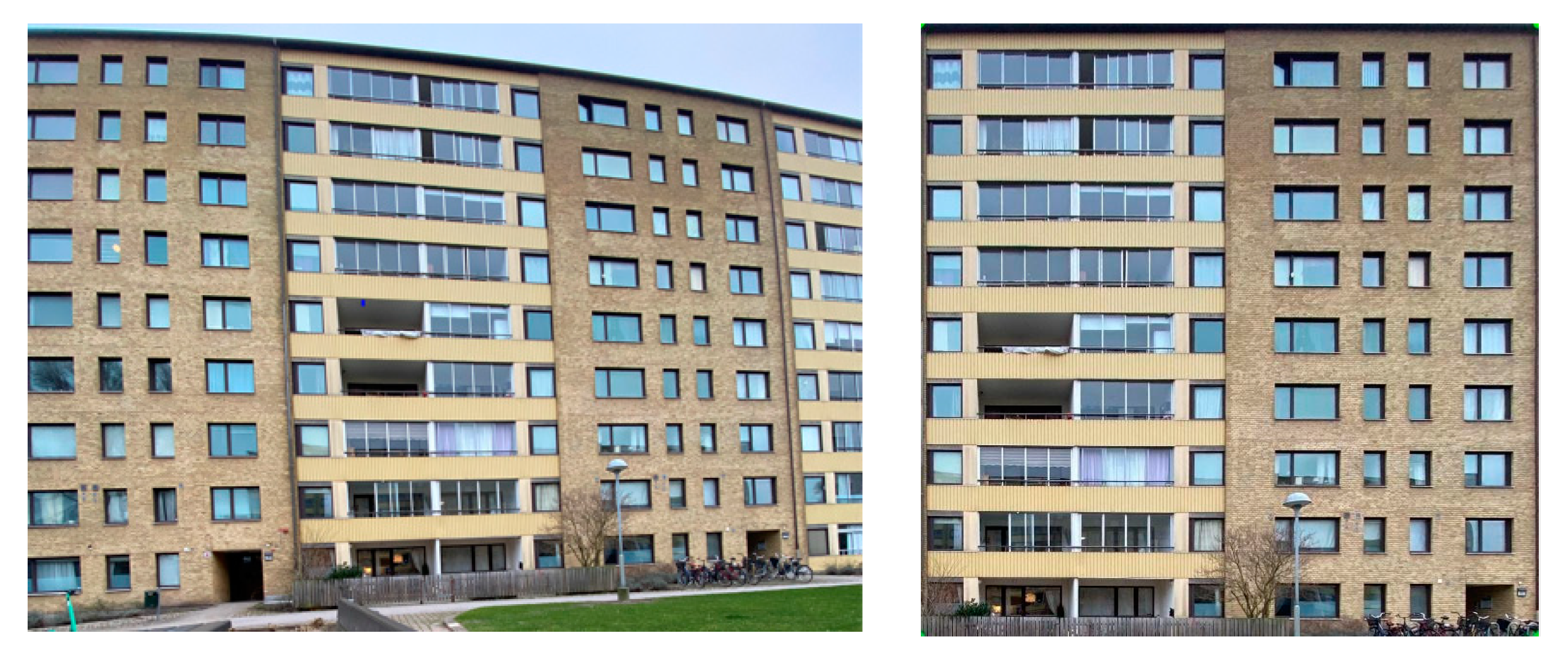
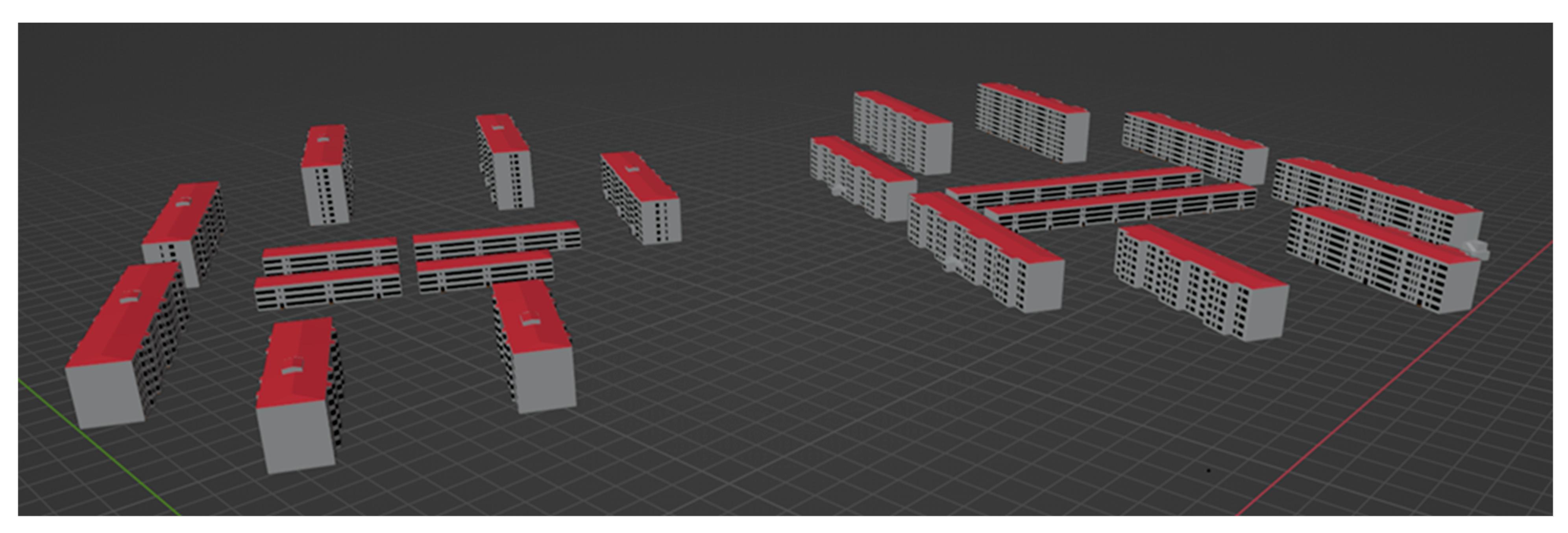
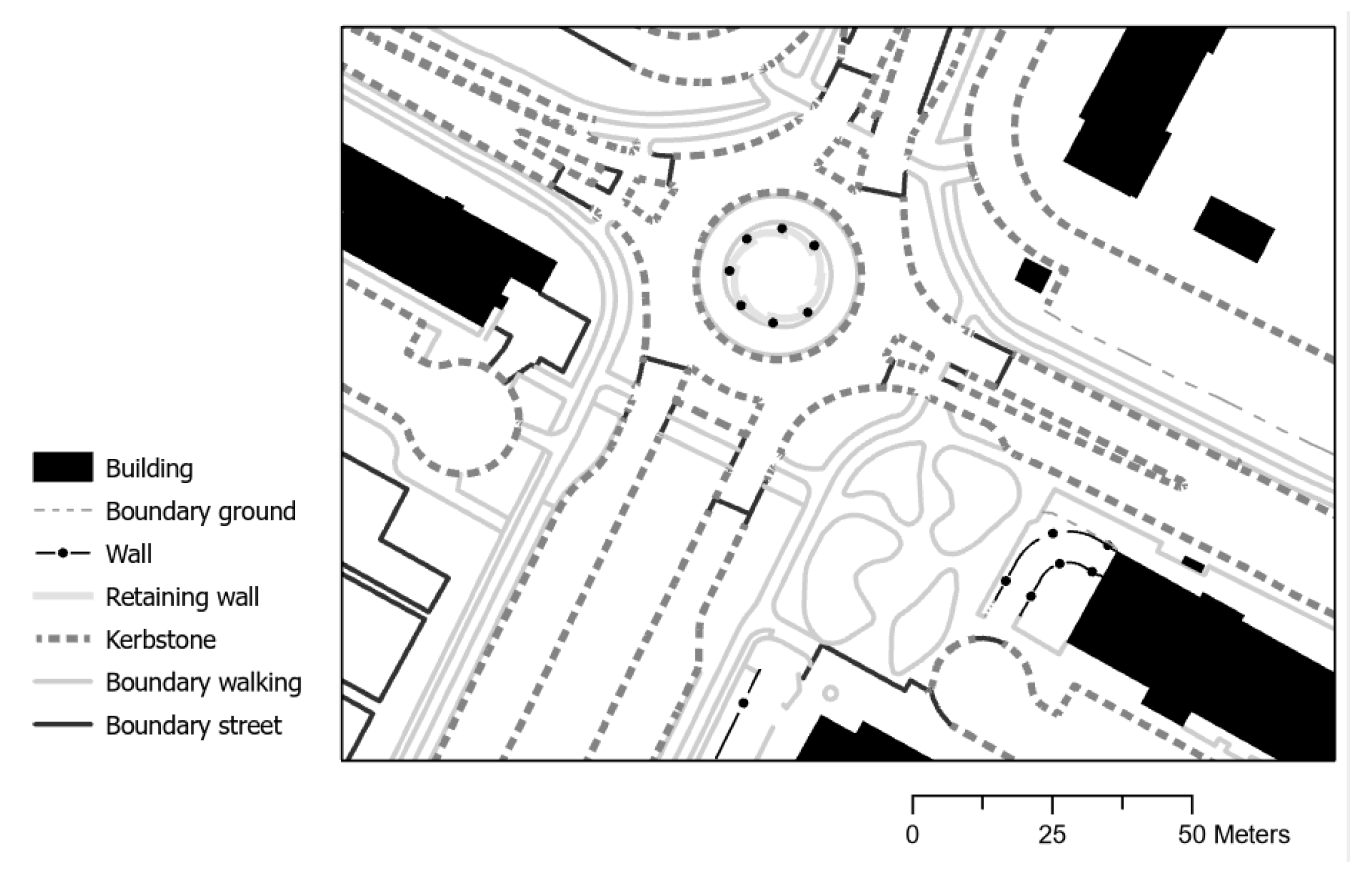

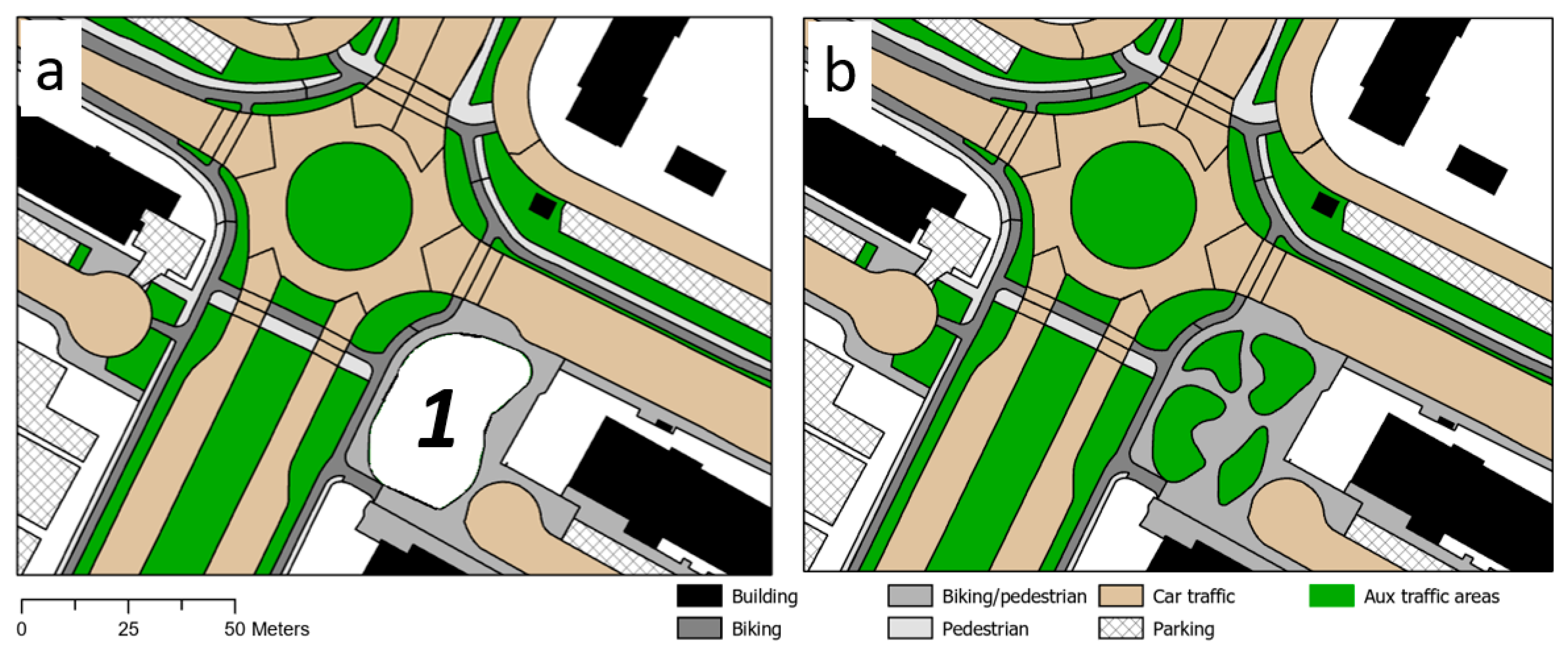

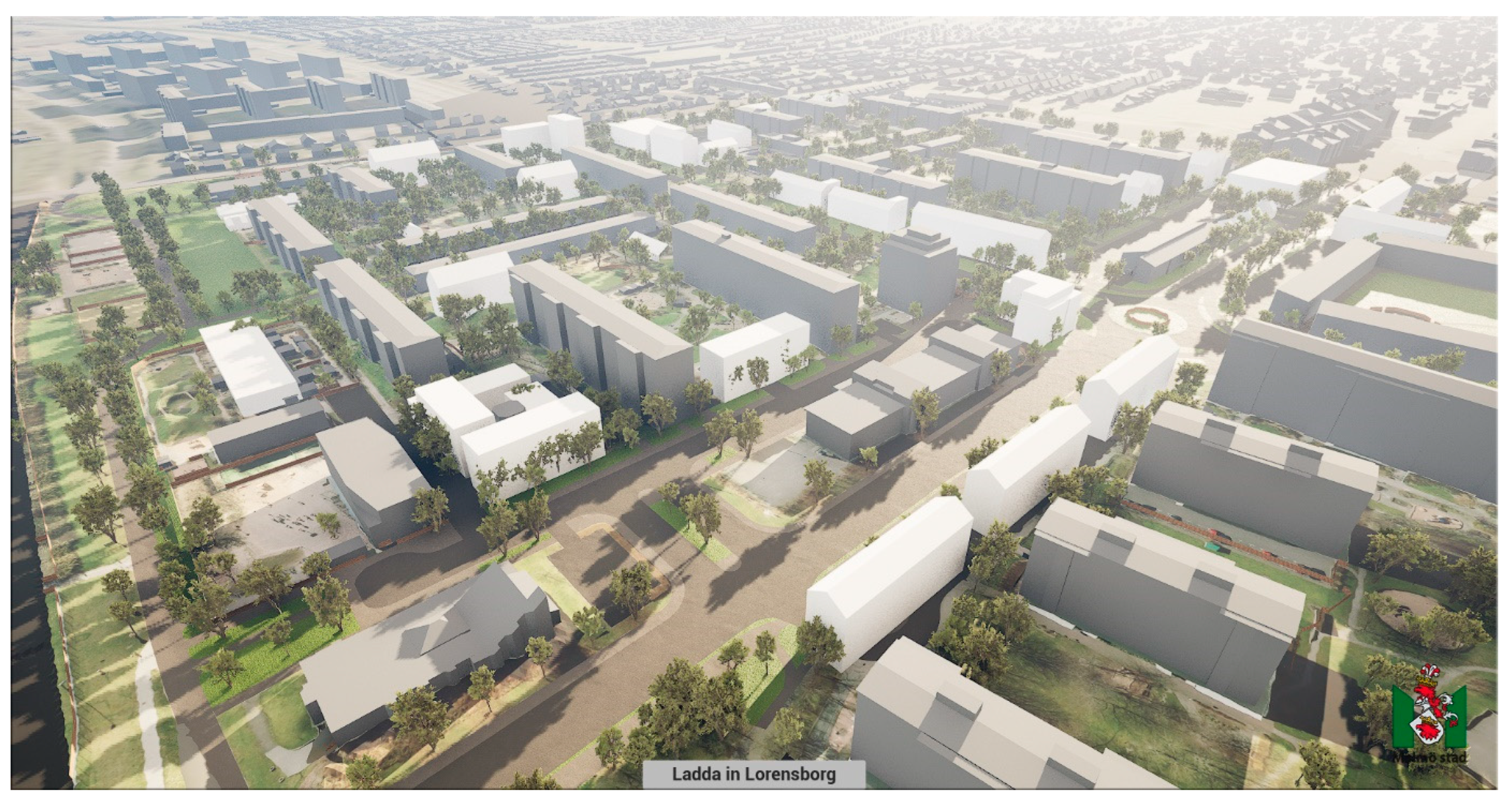
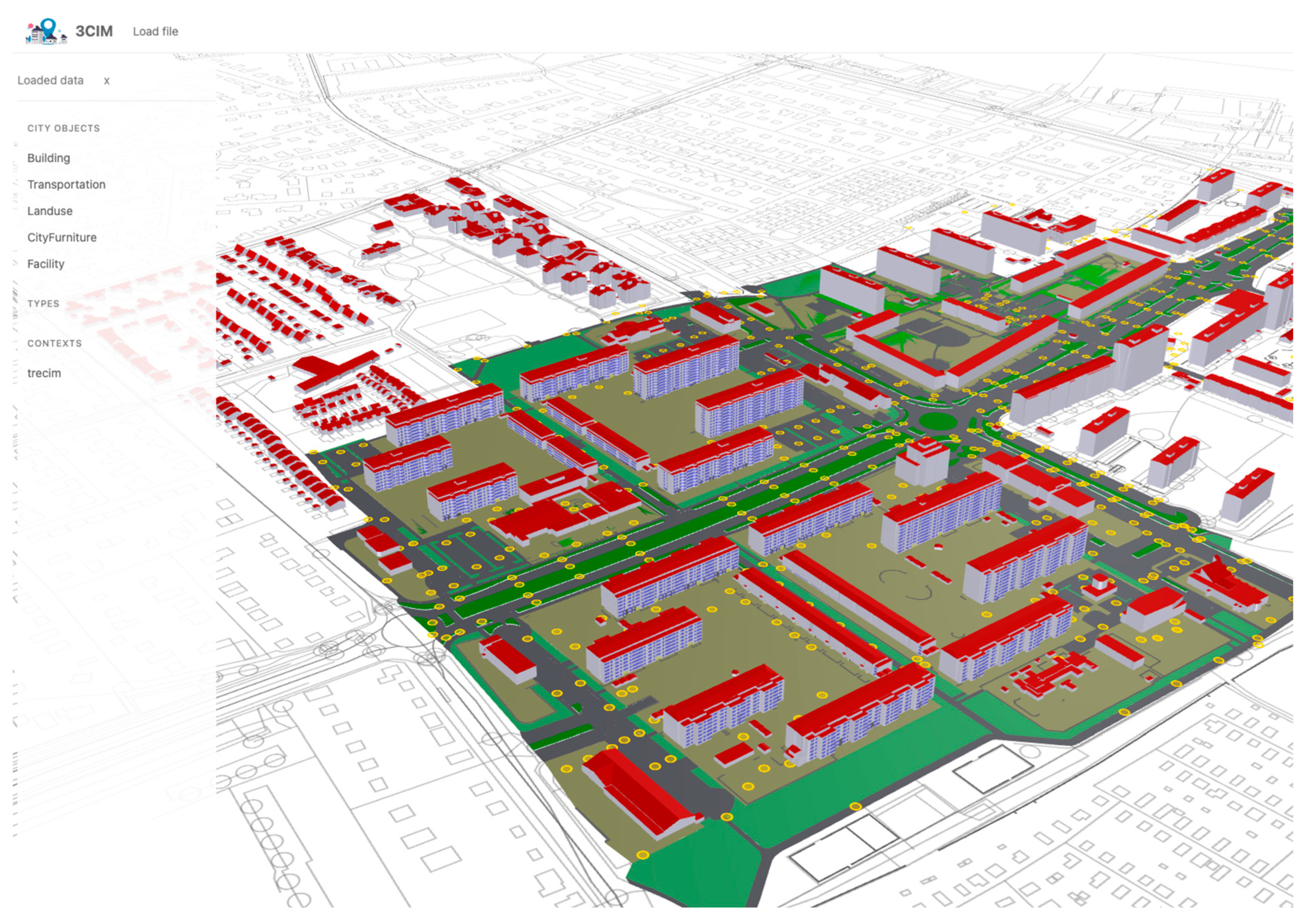
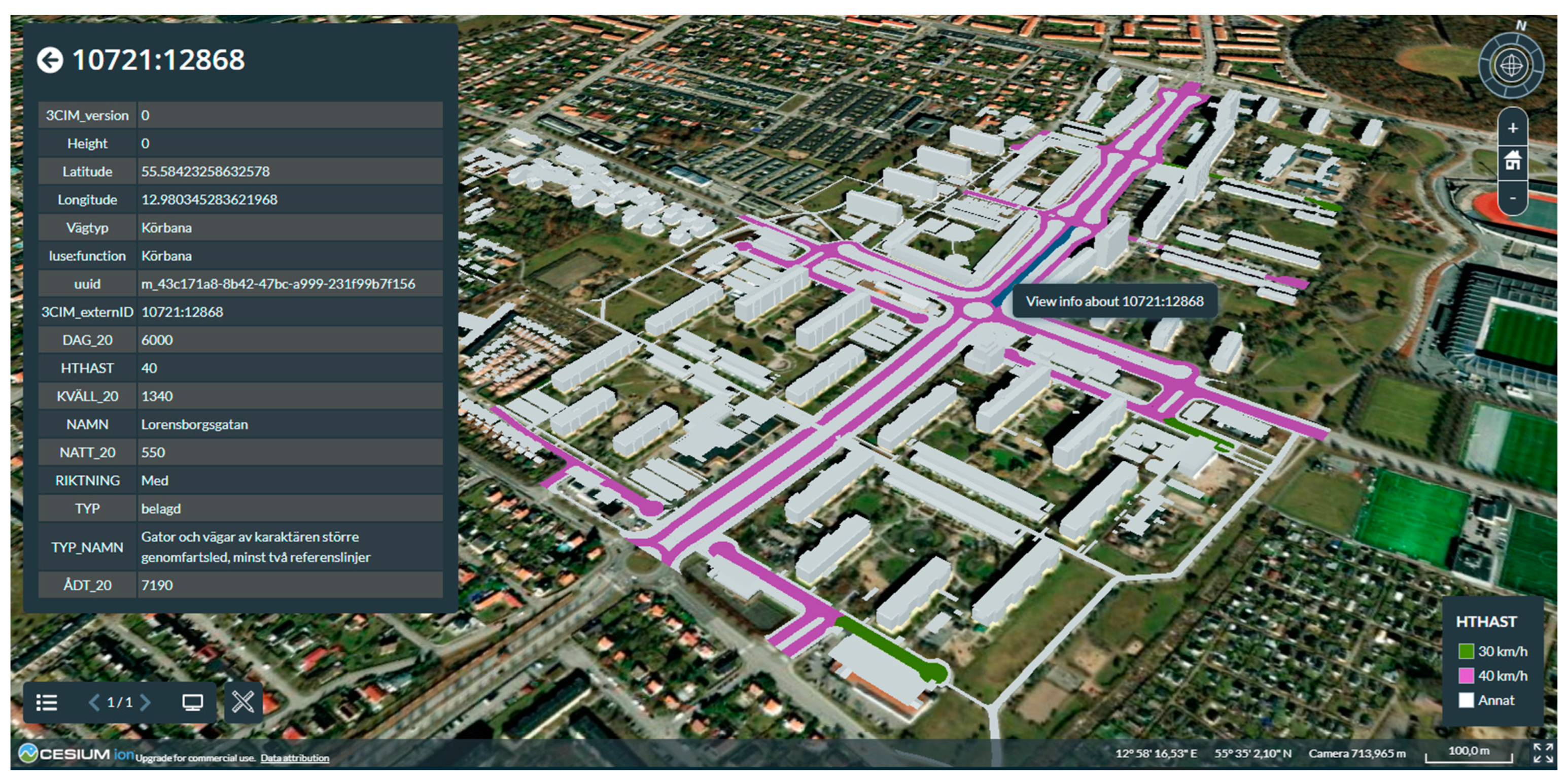


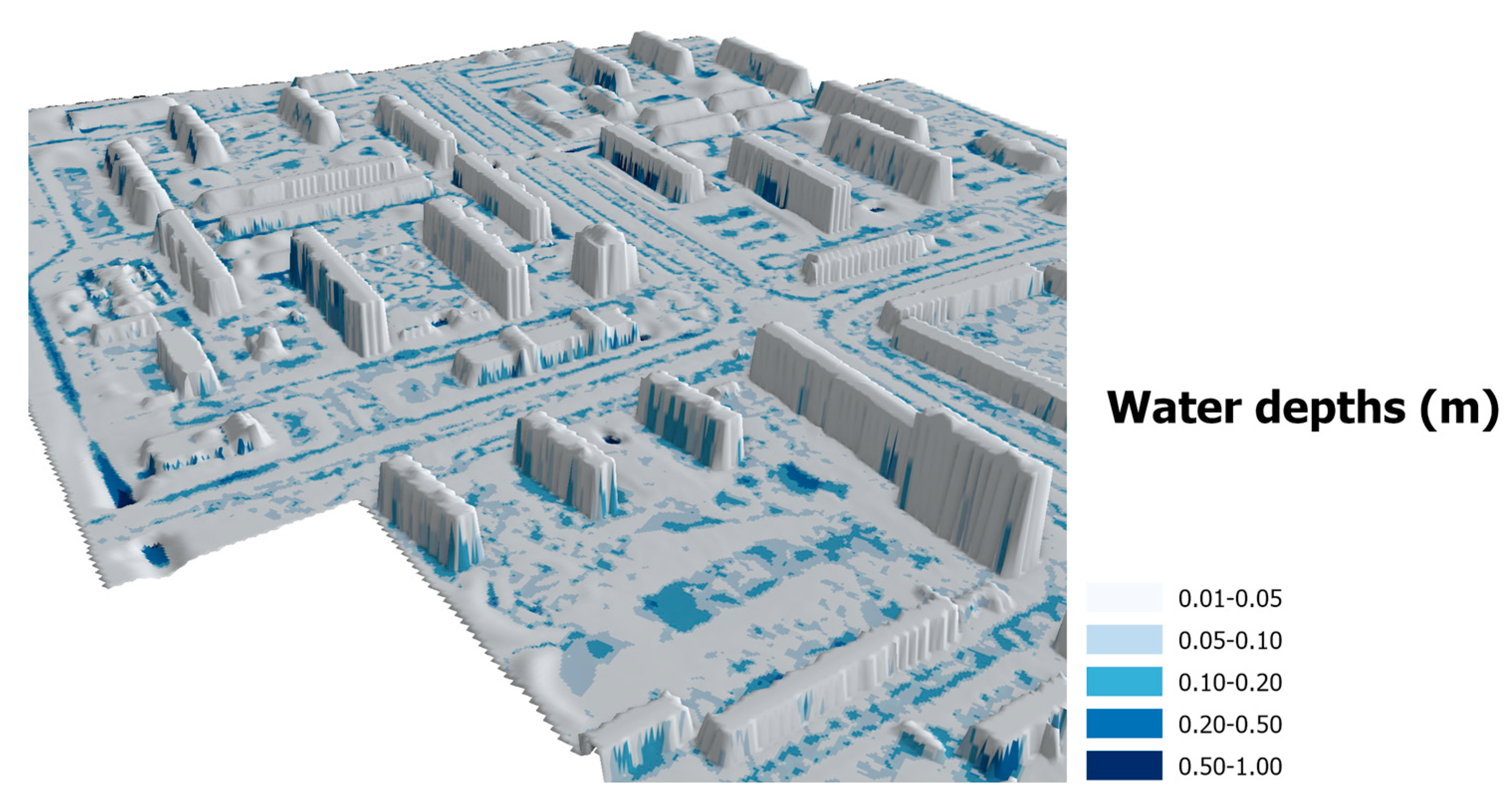
| LOD | ||||
|---|---|---|---|---|
| 0.1 | 2.1 | 2.2 | 2.3 | |
| Terrace >5 m2 | (x) | (x) | (x) | |
| Balcony >0.2 m from facade and >2 m2 | (x) | (x) | (x) | |
| Load berth >5 m2 | (x) | (x) | (x) | |
| Access balcony >0.2 m from facade and >2 m2 | (x) | (x) | (x) | |
| Antenna >2 m high and >2 m2 | x | x | ||
| Ramp >2 m2 | (x) | (x) | (x) | |
| Railing | (x) | (x) | ||
| Chimney >2 m high and >2 m2 | x | x | ||
| Canopy >2 m2 | (x) | (x) | (x) | |
| Solar energy equipment >1 m wide and >2 m2 | (x) | (x) | ||
| Roof window >1 m wide and >2 m2 | (x) | (x) | ||
| Dormer >1 m wide and >2 m2 | (x) | (x) | ||
| Technical supply, e.g., AC ventilation >2 m high and >2 m2 | x | x | ||
| Stairs >2 m2 | (x) | (x) | (x) | |
| Application | Stockholm | Älmhult | Ulricehamn |
|---|---|---|---|
| Noise simulations | |||
| Building permit process | X | X | |
| Urban plan communication | X | F | F |
| Sight analysis | |||
| Shadow analysis | X | X | |
| Sun and daylight simulations | X | X | |
| Urban planning | X | F | X |
Disclaimer/Publisher’s Note: The statements, opinions and data contained in all publications are solely those of the individual author(s) and contributor(s) and not of MDPI and/or the editor(s). MDPI and/or the editor(s) disclaim responsibility for any injury to people or property resulting from any ideas, methods, instructions or products referred to in the content. |
© 2023 by the authors. Licensee MDPI, Basel, Switzerland. This article is an open access article distributed under the terms and conditions of the Creative Commons Attribution (CC BY) license (https://creativecommons.org/licenses/by/4.0/).
Share and Cite
Uggla, M.; Olsson, P.; Abdi, B.; Axelsson, B.; Calvert, M.; Christensen, U.; Gardevärn, D.; Hirsch, G.; Jeansson, E.; Kadric, Z.; et al. Future Swedish 3D City Models—Specifications, Test Data, and Evaluation. ISPRS Int. J. Geo-Inf. 2023, 12, 47. https://doi.org/10.3390/ijgi12020047
Uggla M, Olsson P, Abdi B, Axelsson B, Calvert M, Christensen U, Gardevärn D, Hirsch G, Jeansson E, Kadric Z, et al. Future Swedish 3D City Models—Specifications, Test Data, and Evaluation. ISPRS International Journal of Geo-Information. 2023; 12(2):47. https://doi.org/10.3390/ijgi12020047
Chicago/Turabian StyleUggla, Maria, Perola Olsson, Barzan Abdi, Björn Axelsson, Matthew Calvert, Ulrika Christensen, Daniel Gardevärn, Gabriel Hirsch, Eric Jeansson, Zuhret Kadric, and et al. 2023. "Future Swedish 3D City Models—Specifications, Test Data, and Evaluation" ISPRS International Journal of Geo-Information 12, no. 2: 47. https://doi.org/10.3390/ijgi12020047
APA StyleUggla, M., Olsson, P., Abdi, B., Axelsson, B., Calvert, M., Christensen, U., Gardevärn, D., Hirsch, G., Jeansson, E., Kadric, Z., Lord, J., Loreman, A., Persson, A., Setterby, O., Sjöberger, M., Stewart, P., Rudenå, A., Ahlström, A., Bauner, M., ... Harrie, L. (2023). Future Swedish 3D City Models—Specifications, Test Data, and Evaluation. ISPRS International Journal of Geo-Information, 12(2), 47. https://doi.org/10.3390/ijgi12020047








